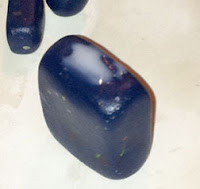Did you know that you should throw away your make-up every
three to six months depending on how gooey it is and if it goes on or near your
eyes? By gooey I mean liquid, creamy type make-ups.
I’ve known this for years, but I can honestly say I never
really did it. I would think about cleaning out my make-up collection and then
lament throwing out all that money. Especially since I don’t wear make-up on a
daily basis. I do wear stage make-up, and when I do, I wear a lot of it!
Well realization hit me that I have a little apothecary set
of drawers full of make-up I do not wear. And I also know I haven’t worn any of
the make-up in those drawers for well over 3 years. Time to say good-bye
expensive make-up collection. Well good-bye to this portion of it. Everthing except whats pictured below got the old heave ho! The rest is a crafting score!
It is not good-bye forever, just good-bye as make-up.
Powder based eye shadows have a wonderful second life in the
world of crafts (blushes, and dusting glitter do too!).
I have matte shadows, and color shift shadows, and shadows
with a ton of sparkles and they are all fabulous for augmenting polymer clay.
So are those blushes and glitter powders. A lot of make up has the same mica
pigments in them as those pricey little jars of mica pigment for crafting.
And apparently they are good for mixing custom personal colors
of nail varnish, and they work very well as soft chalk pastels for coloring in
your rubber stamp creations.
And lets not forget the make up containers. When cleaning up
my make-up, I even scored a few small mirrors for decorating.
Actually the timing was perfect. We have encountered a
project in the Friesen Project that required decorating a mirror jungle style.
I used one of the compact’s mirrors!
After decorating the mirror with a bazillion Christi Friesen
style leaves I decided to use my new crafting pigments (old make-up) to add
color variation and depth to the polymer clay before curing it.
Usually when I use powder pigments I don’t use the acrylic
paint patina technique. I mean why cover it up?
The following images show the mirror before and after, I think you
can really see the amount of depth and detail the pigment adds.

This mirror was completely made from various scrap piles: a throw away make up mirror, scrap pile of clay, left over beads, scrap copper wire, and finished off with old make-up.





















